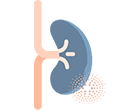Hemolytic Uremic Syndrome Precision Panel
Hemolytic Uremic Syndrome (HUS) is defined by the presence of microangiopathic hemolytic anemia, thrombocytopenia and acute kidney injury. It is one of the main causes of acute kidney injury in children.


Hemolytic Uremic Syndrome (HUS) is defined by the presence of microangiopathic hemolytic anemia, thrombocytopenia and acute kidney injury. It is one of the main causes of acute kidney injury in children. It is a clinically heterogeneous condition given the different etiologies of HUS that result in differences in presentation, management and outcome. It has been classified into typical HUS resulting from Shiga toxin-producing E.coli infections (STEC) and atypical HUS or non-STEC. HUS can be hereditary due to inborn errors of cobalamin C metabolism, complement gene mutations or acquired by infections, autoantibodies or drug toxicity. It is estimated that approximately 50 percent of non-Shiga-toxin-producing E.coli cases result from mutations in these genes. There is a seasonal pattern of HUS, peaking in the summer and fall. The mode of inheritance follows an autosomal dominant or autosomal recessive pattern.
The Igenomix Hemolytic Uremic Syndrome Precision Panel can be used to make a directed and accurate diagnosis ultimately leading to a better management and prognosis of the disease. It provides a comprehensive analysis of the genes involved in this disease using next-generation sequencing (NGS) to fully understand the spectrum of relevant genes involved.
The clinical utility of this panel is:
Noris, M., & Remuzzi, G. (2005). Hemolytic Uremic Syndrome. Journal Of The American Society Of Nephrology, 16(4), 1035-1050. doi: 10.1681/asn.2004100861
Fakhouri, F., Zuber, J., Frémeaux-Bacchi, V., & Loirat, C. (2017). Haemolytic uraemic syndrome. The Lancet, 390(10095), 681-696. doi: 10.1016/s0140-6736(17)30062-4
Loirat, C., Fakhouri, F., Ariceta, G., Besbas, N., Bitzan, M., & Bjerre, A. et al. (2015). An international consensus approach to the management of atypical hemolytic uremic syndrome in children. Pediatric Nephrology, 31(1), 15-39. doi: 10.1007/s00467-015-3076-8
Keir, L. (2015). Shiga Toxin Associated Hemolytic Uremic Syndrome. Hematology/Oncology Clinics Of North America, 29(3), 525-539. doi: 10.1016/j.hoc.2015.01.007
Siegler, R., & Oakes, R. (2005). Hemolytic uremic syndrome; pathogenesis, treatment, and outcome. Current Opinion In Pediatrics, 17(2), 200-204. doi: 10.1097/01.mop.0000152997.66070.e9
Taylor, C., Machin, S., Wigmore, S., & Goodship, T. (2010). Clinical Practice Guidelines for the management of atypical Haemolytic Uraemic Syndrome in the United Kingdom. British Journal Of Haematology, 148(1), 37-47. doi: 10.1111/j.1365-2141.2009.07916.x
Cody, E. M., & Dixon, B. P. (2019). Hemolytic Uremic Syndrome. Pediatric clinics of North America, 66(1), 235–246. https://doi.org/10.1016/j.pcl.2018.09.011